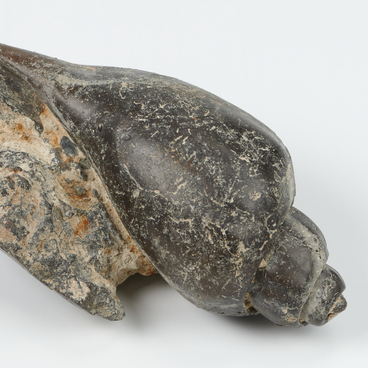A powder flask is a container for storing and carrying gunpowder. When flintlock mechanisms were used in guns, the ignition of gunpowder in them occurred from a spark that was created by the flint striking the frizzen. The spark first ignited a small amount of gunpowder, which was called priming powder. Through the priming hole in the barrel, the flame reached the main charge, and a shot was fired.
The soldiers had to load the gun with gunpowder themselves. Such a system had significant drawbacks: the shooter, not being able to accurately measure the amount of gunpowder needed for a shot, could pour more than necessary. This led to ruptures of the barrel, and the soldiers got injured.
For fine priming powder, a separate powder flask called ‘natruska’ was made. The main powder flask was carved from horn or wood, sewn from leather, or cast from metal: silver, copper or brass. A device for measuring the amount of gunpowder was inserted into the neck. Sometimes the measuring device was kept separately, but in this case, it was cut out of bone. ‘Ears’ were attached to the powder flask so that it could be attached to the belt. The gunpowder was expensive, so the containers for its storage were not supposed to allow water to pass through. The powder flasks used for hunting were also distinguished by the beauty of their design. Various techniques were used for decoration: carving, embossing, painting.
Military powder flasks fell out of use at the end of the 17th century when paper cartridges appeared. With the invention of percussion caps, ‘natruski’ also lost their relevance. The percussion cap mechanism consisted of a hammer-trigger and a nipple, on which a brass cap — the capsule — was put on. The cap contained a chemical mixture called mercuric fulminate. The hammer hit the capsule, which caused the mercuric fulminate to explode. The flame moved down the hollow nipple into the barrel, where it ignited the main powder charge. But when hunting, old guns with powder flasks were used more often, and the older system was also used for dueling pistols.
The powder flask from the Yershov Museum Complex of Ishim City was made out of horn. On the top, the maker attached a closing lever for measuring the gunpowder. On the one side there is an engraving ‘1803’ visible. The exhibit was donated to the museum by Pavel Pyankov in 2002.
The soldiers had to load the gun with gunpowder themselves. Such a system had significant drawbacks: the shooter, not being able to accurately measure the amount of gunpowder needed for a shot, could pour more than necessary. This led to ruptures of the barrel, and the soldiers got injured.
For fine priming powder, a separate powder flask called ‘natruska’ was made. The main powder flask was carved from horn or wood, sewn from leather, or cast from metal: silver, copper or brass. A device for measuring the amount of gunpowder was inserted into the neck. Sometimes the measuring device was kept separately, but in this case, it was cut out of bone. ‘Ears’ were attached to the powder flask so that it could be attached to the belt. The gunpowder was expensive, so the containers for its storage were not supposed to allow water to pass through. The powder flasks used for hunting were also distinguished by the beauty of their design. Various techniques were used for decoration: carving, embossing, painting.
Military powder flasks fell out of use at the end of the 17th century when paper cartridges appeared. With the invention of percussion caps, ‘natruski’ also lost their relevance. The percussion cap mechanism consisted of a hammer-trigger and a nipple, on which a brass cap — the capsule — was put on. The cap contained a chemical mixture called mercuric fulminate. The hammer hit the capsule, which caused the mercuric fulminate to explode. The flame moved down the hollow nipple into the barrel, where it ignited the main powder charge. But when hunting, old guns with powder flasks were used more often, and the older system was also used for dueling pistols.
The powder flask from the Yershov Museum Complex of Ishim City was made out of horn. On the top, the maker attached a closing lever for measuring the gunpowder. On the one side there is an engraving ‘1803’ visible. The exhibit was donated to the museum by Pavel Pyankov in 2002.



